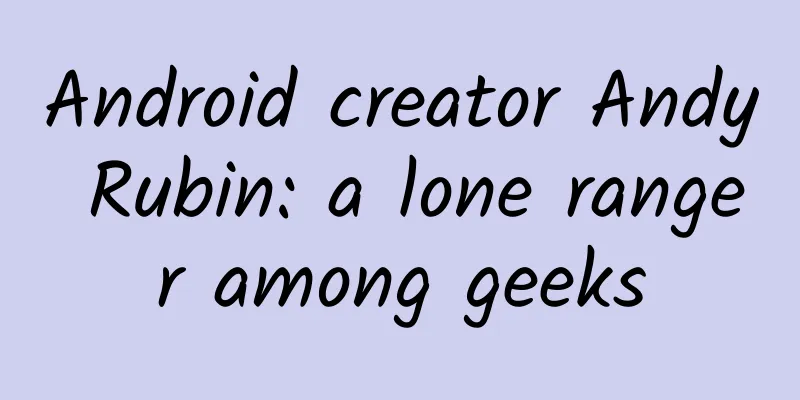Android creator Andy Rubin: a lone ranger among geeks

|
Android co-founder Andy Rubin is reportedly leaving Google. According to The Wall Street Journal, Rubin will create an incubator for hardware startups after leaving Google, and his position at Google will be replaced by James Kuffner, a research scientist at the company and a professor at Carnegie Mellon University. Andy Rubin's decision to leave Google is not surprising. In his 25-year career, Rubin has worked for many companies, such as Apple, Microsoft, Google, etc., responsible for the development of innovative projects in various fields. He will not be content with a stagnant job. When the number of Android users exceeded 1 billion, his departure seemed inevitable. This article summarizes some of the projects Rubin has worked on during his career, and introduces the work experience of this "geeky lone ranger". In AppleIn 1989, after helping a lovelorn man find a place to live, the 26-year-old Rubin was recruited to work at Apple. At that time, Apple was basically controlled by technicians, and strange things always happened. When he first arrived at Apple, Rubin played a prank and reprogrammed the company's internal phone system, causing his colleagues to mistakenly receive a call from then-CEO John Sculley, saying that he would give them stock rewards. Of course, he also did a lot of good things at Apple. Apple's first tower computer, the Quadra, and the first soft modem in history were both inseparable from his efforts. Magic CapIn 1990, Apple spun off its handheld computer division and communications equipment division to form General Magic. Rubin worked day and night to develop the smartphone operating system and interface Magic Cap in the new company. Magic Cap is a stylus-based operating system that completely simulates a real desk, inbox, clock, etc. However, because the concept was too advanced, users did not know what it could do, nor did they know what the people using the computer were doing. Due to poor market performance, his R&D department was soon disbanded. WebTVAfter the company dissolved, he and several colleagues founded Artemis and continued to work day and night. This time, the product he participated in developing was the interactive Internet TV WebTV, which has obtained multiple communication patents, has hundreds of thousands of users, and has an annual revenue of more than $100 million. At MicrosoftIn 1997, Artemis was acquired by Microsoft, and Rubin stayed there. This time he seemed to be out of tune with Microsoft's culture and didn't produce any products, but he still insisted on doing his own thing and caused trouble. At that time, he built a walking robot equipped with a camera and microphone, which wandered around Microsoft and recorded everything it saw. But later, Microsoft security personnel discovered that the robot had been hacked, although the hackers did not know that it could move and had a camera. However, the angry staff still asked Rubin to immediately put the robot into cold storage. SidekickAfter leaving Microsoft, Rubin founded Danger with his friends and developed Sidekick, a mobile device with a screen in the center of the body that can be rotated and stood up, with a keyboard, and can make calls, install applications and surf the Internet. In fact, at first they just wanted to build a camera that can be connected to the Internet, but investors were not interested, so they added a keyboard and wireless communication module to turn it into a mobile phone. It is worth mentioning that in 2002, he went to Stanford University to give a speech about the development process of Sidekick, and Google's two founders Page and Brin were in the audience at the time. This was also the first time they met. After class, Page checked Sidekick and said, "It's really cool." The Beginning of AndroidIn 2007, Rubin claimed that he had completed his mission at Danger and hoped to move on. After several twists and turns, he returned to the idea of developing the next generation of smartphones. So he founded Android and registered Android.com. Some people think that Android is a pseudonym for his own name "Andy", but the term first appeared in the 1886 science fiction novel "Future Eve" by French writer Liya, who named the human-like machine Android. Soon after completing the business plan, venture capitalists expressed interest in the Android project and proposed to acquire it. During the negotiations, Rubin sent an email to Page, hinting at the possibility of Android's cooperation with Google. A few weeks later, Google acquired Android, and Rubin became the vice president of engineering, responsible for the Android project. On November 5, 2007, Google officially announced the Android operating system. We all know what happened next. Looking at Rubin's deeds, his departure is not surprising. He is a lone ranger. According to his colleagues at Google, "Andy is a solo artist who likes to run in one direction and ignore others. When Android grows to a certain scale and needs to interact with partners inside and outside Google, Andy becomes frustrated and unable to manage the business." |
<<: What will happen to robots after Andy Rubin leaves Google?
>>: What does it mean when the father of Android steps down?
Recommend
Are beverages healthy if they use sugar substitutes?
When it comes to sweet things, the first thing th...
Using Domain Events in Microservices
If we think back to the working principle of compu...
Electric Technology Car News: Highlander has long been unable to satisfy the thirsty car buyers. Who will be the next SUV overlord among Trumpchi, Changan and Haval?
With the rapid rise of domestic auto brands, more...
When mobile phones labeled as Meitu, Hammer and OPPO come on the market, how to deal with the risks and opportunities brought by the new consumption changes?
The representation of a consumer brand in the min...
Making money by taking advantage of men's weaknesses, sharing how to play social dating projects
It was probably a coincidence. Just when I was ab...
HTC One with WP8 GDR3 system to be unveiled at the end of the year: supports Wi-Fi data recovery and rotating lock screen
[September 9 news] Screenshots of the WP8 version...
Why can’t Douban’s top influencers get advertising on Weibo?
As a blogger, your own content is like a brand’s ...
Master these 12 operating methods to help you get rid of the stereotyped activity gameplay
I know that it is not easy to be a content operat...
0 cost blog promotion to attract fans, the latest micro-business promotion method strategy
How to use Sina Blog to accurately attract traffi...
The Shenzhou 14 crew took photos in orbit
This year's National Day was the first time t...
He is a master of astrophysics, but also a stumbling block to the development of the discipline?
Arthur Eddington made outstanding contributions i...
Operational tips: 5 ways to quickly increase community activity
I often hear people say that they joined a commun...
Excellent product managers must overcome these three challenges
As a senior product manager, I have encountered c...
90% of copywriters often make these three mistakes. Have you made any of them?
The three most common mistakes in many advertisin...
Why do we want to rub, pinch and bite cute things?
© Tuan Tran/Getty Leviathan Press: This is indeed...









